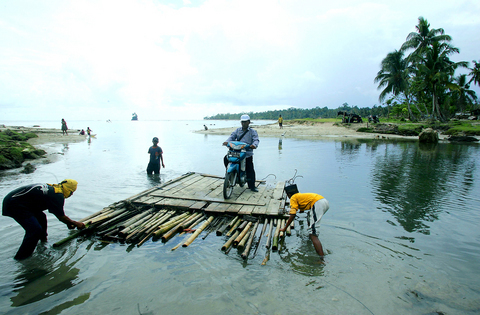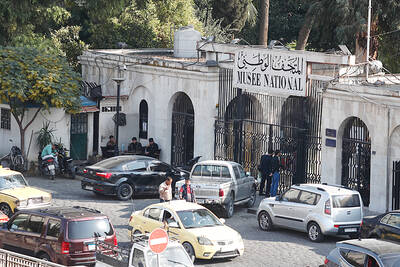The ground shook so hard, people couldn't stand up when the massive earthquake rattled this remote Indonesian island -- the closest inhabited land to the epicenter of the devastating temblor.
But, unlike the hundreds of thousands of others who thought the worst was over when the shuddering stopped, the islanders remembered their grandparents' warnings and fled to higher ground in fear of giant waves known locally as semong.
Within 30 minutes, Simeulue became the first coastline in the world to experience the awesome force of the Dec. 26 tsunami. But only seven of the island's 75,000 people died, thanks to the stories passed down over the generations.

PHOTO: AP
"After the earthquake, I looked for the water to suck out," said Kiro, 50, who like many Indonesians uses one name. "I remember the story of the semong and I ran to the hill."
Simeulue's northern coast is about 60km from the spot where the magnitude-9.0 earthquake shifted the ocean floor along a fault line west of Sumatra Island with enough force to send waves racing across the Indian Ocean.
Waves as high as 10m smacked ashore here, but most people had fled because of the stories about the semong that killed thousands in 1907.
"Everyone ran to the hills," said Randa Wilkinson of the aid agency Save the Children. "They took bicycles and motorbikes and wheelbarrows and piled the kids in whatever they could get them in."
Suhardin, 33, said that when the quake struck he didn't think about his grandmother's stories about the 1907 disaster because nothing happened when another big temblor shook the island three years ago. It was only when a man from another village ran past shouting "Semong! Semong!" that Suhardin and others from Laayon village fled.
The earthquake's power is visible all along Simeulue's picturesque coast. Huge cracks and gashes scar the remains of thick concrete walls that once supported village mosques, bridges lie crumbled in streams running to the ocean and deep fissures split roadways.
The island's northern shore took a direct hit from the waves, which left little standing. Along the western shore, the tsunami spared some villages and destroyed others, leaving a path of snapped palm trees, flattened houses and power poles dangling over roads.
The earthquake tipped the island up 1.2m on one side, exposing rugged blocks of coral reef along parts of the northern coast, said Taufik, an Indonesian official who surveyed the island for the government's meteorological and geophysical agency.
Palm trees that once shaded white-sand beaches are now partially submerged on the southern end of the island, which sank 30cm.
"You can't imagine this and only seven people died," he said. "It's amazing."
He agreed the island's oral history saved countless lives, but noted its lush hills are close to the coast, allowing people to get to safety. In many other places with broader coastal plains, people had few places to run.
Tsunamis are rare in the Indian Ocean and many people in the 11 countries hit by the waves did not know about their potential to swallow tens of thousands of lives in seconds. When the inrushing waves sucked shallow coastal waters out to sea, many people stood on beaches watching or collecting fish flopping on the sand instead of fleeing.
On Simeulue's western coast, survivors stood helplessly on hillsides looking down on the wall of water sweeping entire villages out to sea.
"We watched what we had -- everything -- was gone," said Sukirno, 50. "We stayed in the hills for one week because we were scared."
Some are so traumatized they have gathered planks of wood and built shanties along a road high on a hill overlooking what is left of their seaside village. As aftershocks continue -- some registering magnitude 6.0 -- they say they are in no hurry to return to the lowlands.
But many people have begun rebuilding along the shore, starting with crude wooden shacks on what is left of concrete foundations.
They say they will pass the story of the semong down to future generations, even if another disaster never happens.

Philippine President Ferdinand Marcos Jr yesterday vowed that those behind bogus flood control projects would be arrested before Christmas, days after deadly back-to-back typhoons left swathes of the country underwater. Scores of construction firm owners, government officials and lawmakers — including Marcos’ cousin congressman — have been accused of pocketing funds for substandard or so-called “ghost” infrastructure projects. The Philippine Department of Finance has estimated the nation’s economy lost up to 118.5 billion pesos (US$2 billion) since 2023 due to corruption in flood control projects. Criminal cases against most of the people implicated are nearly complete, Marcos told reporters. “We don’t file cases for

Ecuadorans are today to vote on whether to allow the return of foreign military bases and the drafting of a new constitution that could give the country’s president more power. Voters are to decide on the presence of foreign military bases, which have been banned on Ecuadoran soil since 2008. A “yes” vote would likely bring the return of the US military to the Manta air base on the Pacific coast — once a hub for US anti-drug operations. Other questions concern ending public funding for political parties, reducing the number of lawmakers and creating an elected body that would

A feud has broken out between the top leaders of the far-right Alternative for Germany (AfD) party on whether to maintain close ties with Russia. The AfD leader Alice Weidel this week slammed planned visits to Russia by some party lawmakers, while coleader Tino Chrupalla voiced a defense of Russian President Vladimir Putin. The unusual split comes at a time when mainstream politicians have accused the anti-immigration AfD of acting as stooges for the Kremlin and even spying for Russia. The row has also erupted in a year in which the AfD is flying high, often polling above the record 20 percent it

‘ATTACK ON CIVILIZATION’: The culture ministry released drawings of six missing statues representing the Roman goddess of Venus, the tallest of which was 40cm Investigators believe that the theft of several ancient statues dating back to the Roman era from Syria’s national museum was likely the work of an individual, not an organized gang, officials said on Wednesday. The National Museum of Damascus was closed after the heist was discovered early on Monday. The museum had reopened in January as the country recovers from a 14-year civil war and the fall of the 54-year al-Assad dynasty last year. On Wednesday, a security vehicle was parked outside the main gate of the museum in central Damascus while security guards stood nearby. People were not allowed in because